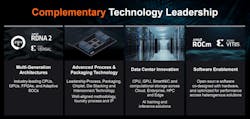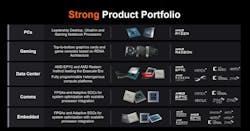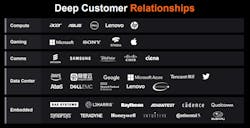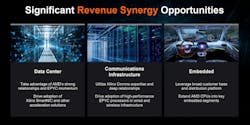AMD Agrees to Buy Xilinx for $35 Billion in Drive to Diversify
Advanced Micro Devices has agreed to buy programmable chip maker Xilinx in a $35 billion deal to diversify its product portfolio and aid its ambitions in data centers and other arenas.
AMD said that the deal, which would be one of the semiconductor industry’s largest unions, would strengthen its bid become one of the leading players in computer processors used in areas including data centers and wireless networks. If the deal closes, AMD and Xilinx would broaden its product range and have a larger base of customers they could sell to together.
AMD said the all-stock deal would create a combined company valued at around $135 billion. That would rival the market values of other leading players in the US semiconductor industry, including Texas Instruments and Qualcomm. If it closes, the combination would also give it the scale and engineering skills to transform into a more formidable challengers to Intel.
Xilinx is the world's largest vendor of programmable chips that can be altered after rolling out of production plants. These types of chips—field programmable gate arrays or FPGAs—can be adapted and upgraded by customers to fit different workloads. Cloud giants and other titans of the technology industry use Xilinx chips to add supplemental performance to server CPUs for networking, storage, and video, image, and other types of processing.
Xilinx chips are also currently widely used in wireless networks, giving it access to valuable customers ahead of the rollout of a new generation of 5G networks around the world.
The $35 billion AMD agreed to pay in the deal underscores the long-term possibilities it hopes to unlock in the combination with Xilinx. AMD said that the deal would grow its total addressable market to $110 billion, expanding its role in areas such as artificial intelligence and servers where customers want more diverse chips to suit a wide range of workloads.
“Our acquisition of Xilinx marks the next leg in our journey to establish AMD as the industry’s high performance computing leader and partner of choice for the largest and most important technology companies in the world,” Lisa Su, the chief executive and president of AMD, said in a statement. “This is truly a compelling combination that will create significant value."
"By combining our efforts, we are bringing together two world-class engineering teams with the technology capability and scale to build even stronger products and solutions," Su added.
The deal would also diversify the Santa Clara, California-based company in areas where it is largely unrepresented. Xilinx chips are also used in aerospace, defense, radar, networking and other embedded systems on factory floors and in automobiles. That would open the door for AMD to engage with new customers in a broader range of markets for its CPUs and GPUs.
AMD said that the combined company is aiming for 20% in average annual sales growth over the long term, the same target as AMD. Under the terms of the proposed pact, Su would lead the new company, while Xilinx CEO Victor Peng would serve as president in charge of Xilinx's business and strategy development. AMD said it would add two Xilinx directors to its board.
The deal has been approved by the boards of both companies. It is subject to approvals by both AMD and Xilinx shareholders and regulators, as well as customary closing conditions.
It is also the latest landmark deal to reshape the semiconductor industry in recent months. Nvidia agreed to buy Arm for $40 billion in cash and stock in August, in what would be the sector's largest deal to date if it closes. Analog Devices has also proposed to buy Maxim Integrated for over $20 billion in stock to bolster its lineup of analog and power management chips.
"Together we will lead the new era of high performance and adaptive computing,” Peng said in a statement. "Joining together with AMD will help to accelerate growth in our data center business and enable us to pursue a far broader customer base across more markets," said Peng, who worked at AMD early in his engineering career and would report directly to Su.
For decades, AMD has played the role of underdog in the market for central processing units (CPUs) used in personal computers and data centers long dominated by Intel. But under Su's leadership in recent years, AMD has been revived its rivalry against Intel and rolled out computer chips based on its Zen architecture that can match its larger rival's. Intel has also been disrupted by delays in the development of its most advanced CPUs.
AMD is also taking advantage of the 7-nanometer node from TSMC to manufacture chips that are as advanced as the 10-nanometer chips that have been delayed for half a decade inside Intel. The company is also planning to roll out graphics processing chips, or GPUs, based on its future CDNA architecture, which it wants to be the gold standard in servers.
AMD is also gaining ground in the market for computer chips used in data centers, mounting its largest assault on Intel's stronghold in the sector. It is selling its Eypc server processors to every major player in the public cloud segment, including Amazon, Microsoft, and Google in the US and with Baidu, Alibaba, and Tencent in China, enlarging its share to double digits.
AMD said the deal would deliver a jolt to its data center business, giving it more diverse chips to sell to lure customers to its products. Over the long term, it could also integrate Xilinx FGPAs and SoCs with the general-purpose CPUs and GPUs it sells to data centers. Xilinx is reportedly supplying chips to Microsoft to run real-time artificial intelligence on Azure, the firm's cloud computing service. Xilinx is also catering to Amazon and Baidu.
"This will enable us to take a leadership position, accelerating a diverse set of emerging workloads," Su said on a conference call with analysts to share details of the deal. "The acquisition of Xilinx is a natural next step in our journey. Xilinx is an ideal match for AMD combining a highly complementary set of products, customers, and markets," she added.
Xilinx has also deepened its lineup of programmable chips used in data centers in recent years. It has started selling its line of Alveo accelerator cards based on its flagship line of server chips, Versal, to run networking, storage, artificial intelligence, and other workloads in servers faster and burning through less power than the central processor in the server.
Xilinx said that its other Alveo accelerator cards slot into servers in sprawling data centers and can run artificial intelligence far faster than Nvidia's Volta GPUs and Intel's Xeon CPUs. The advantage of the FPGA is that it can be reprogrammed by customers not only for the latest advancements in artificial intelligence but just about any other workload in servers.
Xilinx is entering other battlegrounds in data center arena. It has also introduced the first in its new family of server networking cards, or SmartNICs, that are used in the data center to unload more infrastructure chores from the CPU. Nvidia has also introduced a rival line of networking cards that it calls data processing units (DPUs) for use in cloud data centers.
Xilinx would win it further market share in server processors. AMD said it would leverage Xilinx's relationships with telecom equipment giants Ericsson and Samsung Electronics to open a largely untapped $5 billion market for its server CPUs. It could also roll out products pairing AMD CPUs with Xilinx FPGAs and SoCs for the radio, baseband and other parts of 5G networks. "We will have an accelerated path to market," Su said.
“AMD has a brighter long-term future with Xilinx as it creates a larger company that is more diversified across different markets and products while leveraging similar technologies,” said Patrick Moorhead, principal analyst at Moor Insights & Strategy. He said that, while the long term potential of the deal are full of promise, there are also short-term advantages for AMD.
AMD said that, if the deal closes, it would enhance its earnings and profit margins from the start. It promised to cut $300 million in costs within 18 months following the combination.
Others wondered whether the deal would divert it from its primary goal of grabbing market share. "The bigger danger of the merger is that it distracts AMD management from its core business," said semiconductor analyst Linley Gwennap. He fears that AMD is losing focus and that AMD executives "will spend much of their time on this process rather than focusing on continual improvements in its PC and server processors."
AMD said that it would pay for the deal in stock after its shares soared more than 75% from the start of the year, buoyed by the booming demand for chips used in personal computers and data centers as the coronavirus locks large parts of the population at home. AMD's shares have also strengthened due to its execution and its market share gains on Intel.
Under the terms of the agreement, AMD said that it would swap out around 1.72 shares of AMD stock for every share of Xilinx stock. That translates to $143 per share, representing a hefty 25% premium over the company's current value. If the deal closes, AMD shareholders would control 74% of the company while Xilinx shareholders would own 26%.
For AMD, the deal also expands its engineering ranks. The combined company would have a workforce of over 13,000 engineers and boost its investments in research and development.
"We're going to continue to grow R&D," Su said. "We're not counting on any major changes at all in terms of the running of the business. I think the emphasis is that both companies are executing very well and we're going to keep it that way."
The deal should close by the end of 2021, the company said.
About the Author
James Morra
Senior Editor
James Morra is the senior editor for Electronic Design, covering the semiconductor industry and new technology trends, with a focus on power electronics and power management. He also reports on the business behind electrical engineering, including the electronics supply chain. He joined Electronic Design in 2015 and is based in Chicago, Illinois.





